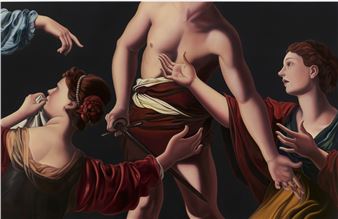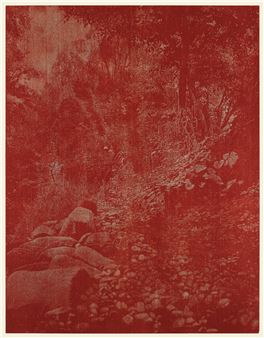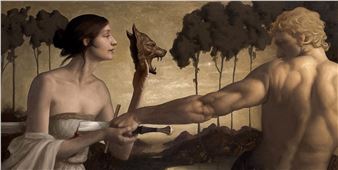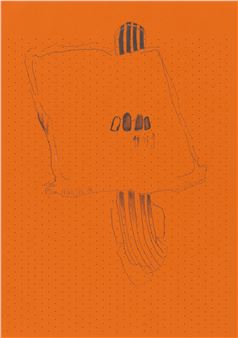Echo Chamber
The Hole is pleased to present Echo Chamber, a group show curated by Leslie Weissman and Charlotte Hailstone. The exhibition explores the cyclical nature of influence, blurring lines between homage, appropriation, and reinvention while questioning originality and celebrating the power of interpretation. Accompanying the show are audio recordings from each artist about their sources of inspiration.
Across thirty-one paintings and sculptures we see artists pulling from film, music, art history and performance filtered through the artist's personal lenses. In Adam Parker Smith ‚ÄúThe Abduction of Proserpina‚ÄĚ Bernini‚Äôs iconic Carrara marble sculpture is seemingly squashed down into a bronze cube. The ankle-height dogs in the original now are cheek-to-cheek with Pluto and Proserpina in an almost comedic crumpling of the iconic original. The take-down of Art History continues in Alexandra Rubenstein‚Äôs ‚ÄúBad Blood‚ÄĚ painted in pig's blood, compositionally inspired by Pablo Picasso‚Äôs ‚ÄúLes Demoiselles d‚ÄôAvignon‚ÄĚ. Here instead of depicting five female prostitutes she paints male artists in the buff‚ÄĒPicasso bottom right, Gauguin in a Russian fur hat, Dal√≠ and Freud right behind‚ÄĒher accompanying audio clip exposing the problematic backgrounds of the male ‚Äúmasters‚ÄĚ of art history.
To quote the problematic Picasso: ‚ÄúGood artists copy, great artists steal‚ÄĚ; in Echo Chamber we see the impact of art history as a treasure trove of ideas for artists to pillage. In Andy Dixon‚Äôs ‚ÄúGetty Villa‚ÄĚ sculptures from the Getty museum's collection are sampled and styled into a rich Bacchanalian still life in acrylic and pastel. Matt Phillip‚Äôs gives us the largest work in the show ‚ÄúHold Tight Horizon Eyes" inspired by the impact and scale of the Garden Frescoes at the Palazzo Massimo in Rome, while Kamoy Smalling‚Äôs, "Portrait of a Man (Triptych)" was painted after seeing a Frans Hals exhibition at the British Museum.
Many contributions nod to art history but seek a more active inquiry into the pop cultural world we live in. Gina Beaver‚Äôs ‚ÄúDelft Al Nails‚ÄĚ remixes Delft pottery with one of Beaver‚Äôs core influences: TikTok makeup tutorials. In ‚ÄúIt‚Äôs My Party And I‚Äôll Cry If I Want To,‚ÄĚ Nicole James references the cheerful tune from the 60s articulated in confetti, mascara-marked tears and fake eyelashes. Melodramatic like the song, the painting deals with the clash of external expectations and internal emotions. In Maya Mason‚Äôs ‚ÄúNorth By Northwest‚ÄĚ we see a still of the film's stars embracing with a self portrait of the artist staring wistfully from the bottom of the canvas. And in Tara Lewis‚Äôs ‚ÄúBatwoman‚ÄĚ and ‚ÄúMarge‚ÄĚ the artist depicts all-grown-up reinterpretation of childhood cartoon memories.
Flirting with nostalgia, Echo Chamber presents work that feels as much about the artist’s identity as it does about the legacy they engage with, examining the difference between derivative work and meaningful dialogue with the past. In Maya Dunn’s "Heirlooms" we see the artist’s Kamon (Japanese family crest) depicted in acrylic and tufted components, the work exploring how traditions and heritage fade, her work not just inspired by history but preserving it with a contemporary reimagining.
To free us from our own art echo chambers, the curators present an interactive element on the plexiglass glass front wall of the show: viewers are encouraged to fill in the blanks on the stickers provided and post them up, continuing the dialogue about the artworks and the role of influence with visitors to the show. When we only encounter our own beliefs and only engage with art we already like, the chamber becomes claustrophobically small, when it could be a chamber to amplify new voices and ideas.

Recommended for you
The Hole is pleased to present Echo Chamber, a group show curated by Leslie Weissman and Charlotte Hailstone. The exhibition explores the cyclical nature of influence, blurring lines between homage, appropriation, and reinvention while questioning originality and celebrating the power of interpretation. Accompanying the show are audio recordings from each artist about their sources of inspiration.
Across thirty-one paintings and sculptures we see artists pulling from film, music, art history and performance filtered through the artist's personal lenses. In Adam Parker Smith ‚ÄúThe Abduction of Proserpina‚ÄĚ Bernini‚Äôs iconic Carrara marble sculpture is seemingly squashed down into a bronze cube. The ankle-height dogs in the original now are cheek-to-cheek with Pluto and Proserpina in an almost comedic crumpling of the iconic original. The take-down of Art History continues in Alexandra Rubenstein‚Äôs ‚ÄúBad Blood‚ÄĚ painted in pig's blood, compositionally inspired by Pablo Picasso‚Äôs ‚ÄúLes Demoiselles d‚ÄôAvignon‚ÄĚ. Here instead of depicting five female prostitutes she paints male artists in the buff‚ÄĒPicasso bottom right, Gauguin in a Russian fur hat, Dal√≠ and Freud right behind‚ÄĒher accompanying audio clip exposing the problematic backgrounds of the male ‚Äúmasters‚ÄĚ of art history.
To quote the problematic Picasso: ‚ÄúGood artists copy, great artists steal‚ÄĚ; in Echo Chamber we see the impact of art history as a treasure trove of ideas for artists to pillage. In Andy Dixon‚Äôs ‚ÄúGetty Villa‚ÄĚ sculptures from the Getty museum's collection are sampled and styled into a rich Bacchanalian still life in acrylic and pastel. Matt Phillip‚Äôs gives us the largest work in the show ‚ÄúHold Tight Horizon Eyes" inspired by the impact and scale of the Garden Frescoes at the Palazzo Massimo in Rome, while Kamoy Smalling‚Äôs, "Portrait of a Man (Triptych)" was painted after seeing a Frans Hals exhibition at the British Museum.
Many contributions nod to art history but seek a more active inquiry into the pop cultural world we live in. Gina Beaver‚Äôs ‚ÄúDelft Al Nails‚ÄĚ remixes Delft pottery with one of Beaver‚Äôs core influences: TikTok makeup tutorials. In ‚ÄúIt‚Äôs My Party And I‚Äôll Cry If I Want To,‚ÄĚ Nicole James references the cheerful tune from the 60s articulated in confetti, mascara-marked tears and fake eyelashes. Melodramatic like the song, the painting deals with the clash of external expectations and internal emotions. In Maya Mason‚Äôs ‚ÄúNorth By Northwest‚ÄĚ we see a still of the film's stars embracing with a self portrait of the artist staring wistfully from the bottom of the canvas. And in Tara Lewis‚Äôs ‚ÄúBatwoman‚ÄĚ and ‚ÄúMarge‚ÄĚ the artist depicts all-grown-up reinterpretation of childhood cartoon memories.
Flirting with nostalgia, Echo Chamber presents work that feels as much about the artist’s identity as it does about the legacy they engage with, examining the difference between derivative work and meaningful dialogue with the past. In Maya Dunn’s "Heirlooms" we see the artist’s Kamon (Japanese family crest) depicted in acrylic and tufted components, the work exploring how traditions and heritage fade, her work not just inspired by history but preserving it with a contemporary reimagining.
To free us from our own art echo chambers, the curators present an interactive element on the plexiglass glass front wall of the show: viewers are encouraged to fill in the blanks on the stickers provided and post them up, continuing the dialogue about the artworks and the role of influence with visitors to the show. When we only encounter our own beliefs and only engage with art we already like, the chamber becomes claustrophobically small, when it could be a chamber to amplify new voices and ideas.
Artists on show
- Adam Parker Smith
- Alejandra Moros
- Alexandra Rubinstein
- Andy Dixon
- Angela Fraleigh
- Charlotte Hailstone
- Danielle Roberts
- Gina Beavers
- Jared Friedman
- Kamoy Smalling
- Katelyn Ledford
- Lauren Cohen
- Lizzy Lunday
- Matt Phillips
- Maya Mason
- Melanie Delach
- Mia Dunn
- Michella Roman
- Nicole James
- Summer Wheat
- Takura Suzuki
- Tara Lewis
Related articles
After several years during which galleries have focused relentlessly on narrative and figurative work, I feel a vibe shift in the air. Is it wishful thinking or is abstract painting roaring back?

 ARTISTS
ARTISTS















